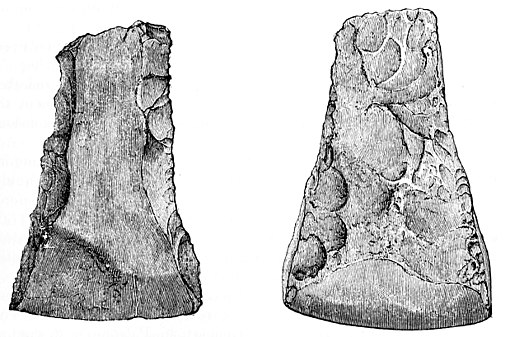Now, these polished flints (Figs. 2 and 3), these stone hatchets (Figs. 4 and 5), were found in the earth associated with the bones of elephants; whence he concluded that the men who had fashioned them lived at the same epoch with those great mammifers long since extinct.
This conclusion, drawn by M. Boucher de Perthes, was at first vigorously contested. In particular, some of the men whose decisions have justly the highest authority on questions relating to the history of the earth, thought that the chipped flints and the bones of elephants
| Fig. 4. | Fig. 5. |
 | |
| Flint Hatchets. | |
were found together in the same bed because this bed had been altered. They said: A first bed was formed which enclosed the bones of elephants. On this bed, during the present period, men lived and have left these chipped flints as a trace of their presence. Then came a mighty tempest, which rolled and confounded together the hatchets and the elephants' bones. Hence we now find them side by side, although the bed to which they belong contains the remains of two perfectly distinct epochs.
It will be apparent to you that, if, in our day, men were buried in this bed of Menchecourt and of Moulin-Quignon, and, if a great storm should come and mingle these modern bones with the hatchets and bones of elephants, our grandchildren would find them all mixed together, and yet the men of to-day are not contemporaneous with the hatchets you see before you.
The objection was all the stronger for having been advanced, as I have said, by the highest authorities in Geology. This is why I attach
